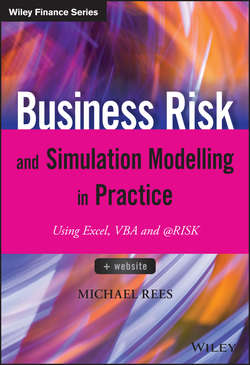Business Risk and Simulation Modelling in Practice

Реклама. ООО «ЛитРес», ИНН: 7719571260.
Оглавление
Rees Michael. Business Risk and Simulation Modelling in Practice
Preface
About the Author
About the Website
Part I. An Introduction to Risk Assessment – Its Uses, Processes, Approaches, Benefits and Challenges
CHAPTER 1. The Context and Uses of Risk Assessment
1.1 Risk Assessment Examples
1.2 General Challenges in Decision-Making Processes
1.3 Key Drivers of the Need for Formalised Risk Assessment in Business Contexts
1.4 The Objectives and Uses of General Risk Assessment
CHAPTER 2. Key Stages of the General Risk Assessment Process
2.1 Overview of the Process Stages
2.2 Process Iterations
2.3 Risk Identification
2.4 Risk Mapping
2.5 Risk Prioritisation and Its Potential Criteria
2.6 Risk Response: Mitigation and Exploitation
2.7 Project Management and Monitoring
CHAPTER 3. Approaches to Risk Assessment and Quantification
3.1 Informal or Intuitive Approaches
3.2 Risk Registers without Aggregation
3.3 Risk Register with Aggregation (Quantitative)
3.4 Full Risk Modelling
CHAPTER 4. Full Integrated Risk Modelling: Decision-Support Benefits
4.1 Key Characteristics of Full Models
4.2 Overview of the Benefits of Full Risk Modelling
4.3 Creating More Accurate and Realistic Models
4.4 Using the Range of Possible Outcomes to Enhance Decision-Making
4.5 Supporting Transparent Assumptions and Reducing Biases
4.6 Facilitating Group Work and Communication
CHAPTER 5. Organisational Challenges Relating to Risk Modelling
5.1 “We Are Doing It Already”
5.2 “We Already Tried It, and It Showed Unrealistic Results”
5.3 “The Models Will Not Be Useful!”
5.4 Working Effectively with Enhanced Processes and Procedures
5.5 Management Processes, Culture and Change Management
Part II. The Design of Risk Models – Principles, Processes and Methodology
CHAPTER 6. Principles of Simulation Methods
6.1 Core Aspects of Simulation: A Descriptive Example
6.2 Simulation as a Risk Modelling Tool
6.3 Sensitivity and Scenario Analysis: Relationship to Simulation
6.4 Optimisation Analysis and Modelling: Relationship to Simulation
6.5 Analytic and Other Numerical Methods
6.6 The Applicability of Simulation Methods
CHAPTER 7. Core Principles of Risk Model Design
7.1 Model Planning and Communication
7.2 Sensitivity-Driven Thinking as a Model Design Tool
7.3 Risk Mapping and Process Alignment
7.4 General Dependency Relationships
7.5 Working with Existing Models
CHAPTER 8. Measuring Risk using Statistics of Distributions
8.1 Defining Risk More Precisely
8.2 Random Processes and Their Visual Representation
8.3 Percentiles
8.4 Measures of the Central Point
8.5 Measures of Range
8.6 Skewness and Non-Symmetry
8.7 Other Measures of Risk
8.8 Measuring Dependencies
CHAPTER 9. The Selection of Distributions for Use in Risk Models
9.1 Descriptions of Individual Distributions
9.2 A Framework for Distribution Selection and Use
9.3 Approximation of Distributions with Each Other
CHAPTER 10. Creating Samples from Distributions
10.1 Readily Available Inverse Functions
10.2 Functions Requiring Lookup and Search Methods
10.3 Comparing Calculated Samples with Those in @RISK
10.4 Creating User-Defined Inverse Functions
10.5 Other Generalisations
CHAPTER 11. Modelling Dependencies between Sources of Risk
11.1 Parameter Dependency and Partial Causality
11.2 Dependencies between Sampling Processes
11.3 Dependencies within Time Series
Part III. Getting Started with Simulation in Practice
CHAPTER 12. Using Excel/VBA for Simulation Modelling
12.1 Description of Example Model and Uncertainty Ranges
12.2 Creating and Running a Simulation: Core Steps
12.3 Basic Results Analysis
12.4 Other Simple Features
12.5 Generalising the Core Capabilities
12.6 Optimising Model Structure and Layout
12.7 Bringing it All Together: Examples Using the Simulation Template
12.8 Further Possible uses of VBA
CHAPTER 13. Using @RISK for Simulation Modelling
13.1 Description of Example Model and Uncertainty Ranges
13.2 Creating and Running a Simulation: Core Steps and Basic Icons
13.3 Simulation Control: An Introduction
13.4 Further Core Features
13.5 Working with Macros and the @RISK Macro Language
13.6 Additional In-Built Applications and Features: An Introduction
13.7 Benefits of @RISK over Excel/VBA Approaches: A Brief Summary
WILEY END USER LICENSE AGREEMENT
Отрывок из книги
This book aims to be a practical guide to help business risk managers, modelling analysts and general management to understand, conduct and use quantitative risk assessment and uncertainty modelling in their own situations. It is intended to provide a solid foundation in the most relevant aspects of quantitative modelling and the associated statistical concepts in a way that is accessible, intuitive, pragmatic and applicable to general business and corporate contexts. It also discusses the interfaces between quantitative risk modelling activities and the organisational context within which such activities take place. In particular, it covers links with general risk assessment processes and issues relating to organisational cultures, incentives and change management. Some knowledge of these issues is generally important in order to ensure the success of quantitative risk assessment approaches in practical organisational contexts.
The text is structured into three parts (containing 13 chapters in total):
.....
• Cognitive. These are biases that are inherent to the human psyche, and often believed to have arisen for evolutionary reasons.
• Structural. These are situations where a particular type of approach inherently creates biases in the results, as a result of the methodology and tools used.
.....